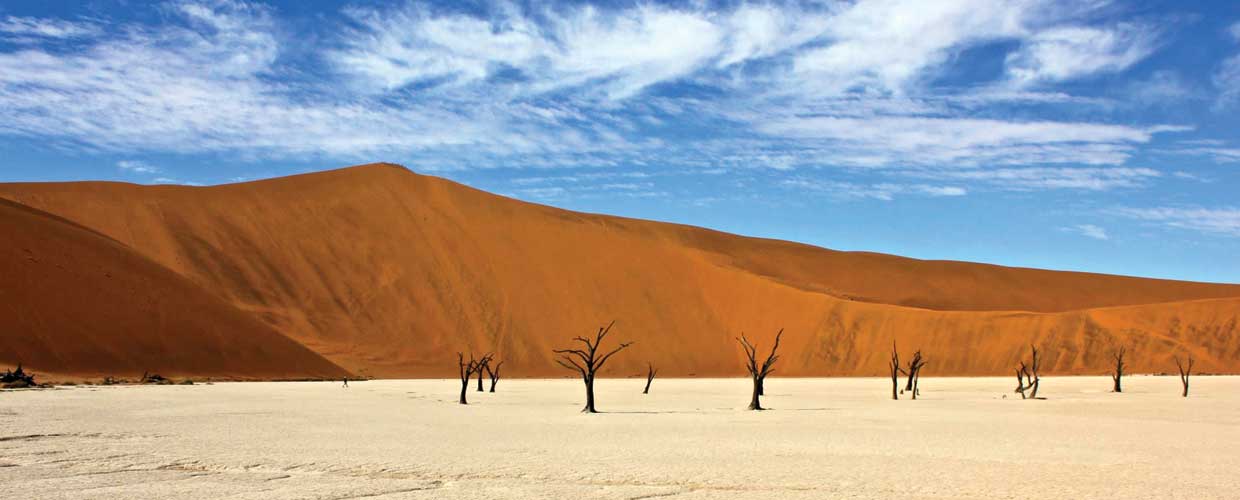
T he Land of Open Spaces, as Namibia is affectionately known, with its undiscovered landscapes and unspoiled nature, makes for a perfect and widely diverse travel destination. The well-developed road infrastructure, abundance of scheduled tours and charter companies, and the friendly welcoming people will ensure that your visit to Namibia is an unforgettable experience. Whether you’re in search of the perfect romantic breakaway, ultimate adventure or are just wishing to lose yourself in the wildlife, cultural diversity and mesmerising scenery reflecting Namibia’s untouched beauty, the following information and tips will leave you well equipped to explore even the remotest parts of the country.
Quick Facts
Surface area: 824, 268 km²
Capital: Windhoek
Independence: 21 March 1990
Current president: Hage Geingob
Multiparty parliament
Democratic constitution
Division of power between executive, legislature and judiciary
Secular state – freedom of religion (90% Christian)
Freedom of the press/media
Nature reserves: 15% of surface area
Highest mountain: Brandberg
Other prominent mountains: Spitzkoppe, Moltkeblick, Gamsberg
Perennial rivers: Orange, Kunene, Okavango, Zambezi and Kwando/Linyanti/Chobe
Ephemeral rivers: Numerous, including Fish, Kuiseb, Swakop and Ugab
14 vegetation zones
120 species of trees
200 endemic plant species
100 plus species of lichen
Living fossil plant: Welwitschia mirabilis
Main sectors: Mining, fishing, tourism & agriculture
Biggest employer: Agriculture (46%)
Fastest growing sector: Tourism
Mining: Diamonds, uranium, copper, lead, zinc, magnesium, cadmium, arsenic, pyrites, silver, gold, lithium minerals, dimension stones (granite, marble, blue sodalite) and many semi-precious stones
Roads: 5450 km tarred, 37 000 km gravel
Harbours: Walvis Bay, Lüderitz
Main airports: Hosea Kutako International Airport, Eros Airport, 46 airstrips
Rail network: 2 382 km narrow gauge
Telecommunications: 6.2 telephone lines per 100 inhabitants
Direct dialing facilities to 221 countries
Postal service: affiliated to the Universal Postal Union
One medical doctor per 3 650 people
Three privately run hospitals in Windhoek with intensive care units
Medical practitioners (world standard)
24-hour medical emergency services
2.3 million
Density: 2.2 per km²
400 000 inhabitants in Windhoek (15% of total)
Official language: English
14 regions, 13 ethnic cultures, 16 languages and dialects
Adult literacy rate: 85%
Population growth rate: 2.6%
Educational institutions: over 1700 schools, various vocational and tertiary institutions
Big game: Elephant, lion, rhino, buffalo, cheetah, leopard, giraffe
20 antelope species
240 mammal species (14 endemic)
250 reptile species
50 frog species
676 bird species
Endemic birds including Herero chat, rock runner, Damara tern, Monteiro’s hornbill
More than 50 countries have Namibian consular or embassy representation in Windhoek.
All goods and services are priced to include value-added tax of 15%. Visitors may reclaim VAT.
Enquiries: Ministry of Finance Tel (+264 61) 23 0773 in Windhoek
Currency: The Namibia Dollar (N$) is fixed to and on par with the SA Rand. The South African Rand is also a legal tender. foreign currency, international Visa, MasterCard, American Express and Diners Club credit cards are accepted.
Most tap water is purified and safe to drink.
Visitors should exercise caution in rural areas.
Public transport is NOT available to all tourist destinations in Namibia.
There are bus services from Windhoek to Swakopmund as well as Cape Town/Johannesburg/Vic Falls. Namibia’s main railway line runs from the South African border, connecting Windhoek to Swakopmund in the west and Tsumeb in the north. There is an extensive network of international and regional flights from Windhoek and domestic charters to all destinations.
Summer time: GMT + 2 hours from the first Sunday in September to the 1st Sunday in April.
Winter time: GMT + 1 hour from the 1st Sunday in April to the 1st Sunday in September.
220 volts AC, 50hz, with outlets for round three-pin type plugs
Ai-Ais Game Park, Etosha National Park, Namib-Naukluft Park (Sesriem entrance), Waterberg Plateau Park, Skeleton Coast Park:
Children
- Under 16 – no charge
Adults
- Foreign N$80.00
- SADC N$60.00
- Namibian residents N$30.00
Vehicles
- 10 seats or less N$10.00
- 11-25 seats N$40.00
- 26- 50 seats N$300.00
- 51 plus N$500.00
All other parks where usage fees are charged:
Caprivi Game Park, Daan Viljoen Game Park, Hardap Recreation Resort, Khaudom Game Park, Mahango Game Park, Mamili National Park, Mudumu National Park, Namib-Naukluft Park (other entrances), Naute Recreation Resort, Von Bach Recreation Resort
Children
- Under 16 – no charge
Adults
- Foreign N$40.00
- SADC N$30.00
- Namibian residents N$10.00
Vehicles
- 10 seats or less N$10.00
- 11-25 seats N$40.00
- 26-50 seats N$300.00
- 51 plus N$500.00
1. Fees are valid for a 24 hour period beginning at time of entry, per person, for one park.
2. Park fees are payable for every day, for visitors and vehicles.
3. The minimum amount payable is for 24 hours (1day), and thereafter in units of 24 hours (1 day).
4. Fees are non-refundable, and non-transferable.
5. Namibian and SADC discount rates are available on production of valid identification
